Most Palestinians are familiar with arak, that milky-white anise-flavored spirit that pairs so well with our delicious cuisine, but very few are aware of our unique distilling heritage, and therefore arak has not received the recognition and respect it deserves.
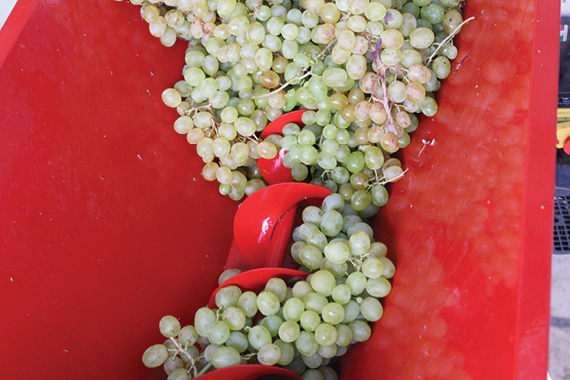
Arabs invented distilled spirits
For millennia, chemists in Greece and Rome sought to increase the natural levels of alcohol in wine and beer, which they already produced in abundance. They tried to do this through distillation, the process of separating the components of a liquid through boiling and condensation. None succeeded, and it’s very likely that many went blind or died from methanol poisoning in their attempts. By the fifth century, Western Europe was in the midst of the Dark Ages, when little scientific advancement was made. Arabs picked up where the Greeks and Romans left off, making substantial contributions to chemistry, among other disciplines.
Roughly 400 years later, Arab Muslim academic Jabir ibn Hayyan – recognized today as the creator of algebra and the father of chemistry – established the principles of classifying liquid substances by their properties and invented the equipment and techniques to isolate them. One of Hayyan’s many inventions was the alembic pot still, which he used to distill various liquids. During an experiment to refine the production of al-kohl (eyeliner), he distilled wine – which he discovered resulted in a clear, highly potent spirit. By then, Islam had already forbidden intoxicants, so Hayyan wasn’t interested in the spirit beyond its academic value. Thus, he concluded that it was “of little use, but of great significance to science.”
Not everyone felt the same way. In fact, many Arabs of the Levant and Mesopotamia began to consume the spirit for enjoyment. Abu Nuwas, a ninth-century Arab poet, wrote that he found inspiration in a wine that “has the color of rainwater but is as hot inside the ribs as a burning firebrand.” Fans of the new drink began referring to it as “al-kohl,” after Hayyan’s accidental discovery. When al-kohl reached European ports, the term was heard and mispronounced as “alcohol,” which – of course – remains in use today.
The coincidental discovery of arak
Interestingly, the fusion of aniseed oil and alcohol, which created arak, was just as accidental as the discovery of distilled spirits. As word of Hayyan’s alembic pot still spread throughout the Middle East, artisans began to make and sell them to home-distillers. People used the technology to turn surplus wine into al-kohl before it could oxidize. They also used it to produce rosewater, orange-blossom water, and herbal essential oils that go into sweets, perfumes, and medicines. Today, distillers use separate stills for spirits and essential oils, as the latter creates residues that can infuse unwanted aromas and flavors into spirits. But at the time, alembic pot stills were expensive, so people used the same one for multiple concoctions.
As this was happening, aniseed was growing in popularity throughout the Middle East as a miracle drug. People boiled it in water and consumed it as a tea to cure abdominal pain, colic, indigestion, menstrual cramping, coughs, and headaches. Some even ground aniseed into powder to mix with flour for flavorful baked goods. Due to its popularity, aniseed was one of the first herbs to be distilled into an essential oil, anethole. In fact, the market for anethole was so strong that nearly every distiller in the Levant and Mesopotamia took part in its production. These distillers, historians believe, inadvertently fused the residue of aniseed oil with alcohol to create the first anise-flavored spirit.
Drinkers preferred the sweet taste of the anise-flavored spirit to the unflavored eau de vie produced until then. As a result, distillers began to distill alcohol with aniseed on purpose, adding a stronger dose of anethole to aid with indigestion, a common ailment associated with summer barbecues. This conscious fusion required a slower distillation process, which caused the spirit to exit the still’s condenser drop by drop. These drops resembled the distillers’ sweat as they hunkered down next to their hot stills. Thus, the new spirit was called arak, Arabic for perspiration. Later on, when someone discovered that diluting arak with water turned it white, the spirit earned the nickname halib al-assad or lion’s milk.
Arak, our national spirit, is the oldest spirit in the world and the mother of all distilled spirits.
Arak quickly went international


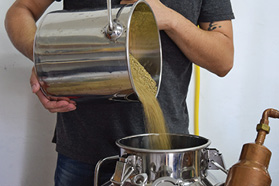
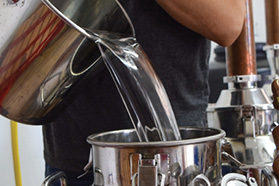
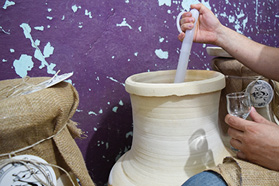

Just as with al-kohl, Arab merchants shipped arak to countries throughout the Mediterranean Basin. It wasn’t long before these nations began to produce their own versions of the spirit, each modifying it slightly. The Greeks, for example, added more herbs and named it ouzo; the French aged it in oak barrels and called it pastis; the Italians sweetened it and dubbed it sambuca; the Tunisians made it from figs and referred to it as boukha; and the Moroccans produced it from dates and named it mahia. Interestingly, only the Turks stuck with the original recipe, and they named it raki, because they discovered it in Iraq, and so to them, it was Iraqi. When Spain and Portugal colonized Latin America, they brought with them their interpretations of arak, anis, which is now produced throughout the region under the name aguardiente, as well as in the Philippines, under the name anisado.
Many Northern and Western countries later dropped the aniseed due to its unavailability and began to produce spirits from more abundantly available grains, rather than fruit. This resulted in unflavored spirits such as vodka, as well as other infused spirits such as gin. Unlike the Middle East, where clay amphorae were widely used for storage, the West largely relied on oak barrels. Flavors and color extracted from these barrels created the category of brown spirits, such as brandy, whiskey, tequila, and rum.
But arak didn’t just spread to the West. It also went eastward. In the thirteenth century, when the Mongol hordes of Genghis Khan invaded China, Central Asia, and the Middle East, the conquerors tried arak, loved it, and spread it throughout the Mongol Empire. Chinese historians have noted that in China, the earliest spirits were distilled during the Ming Dynasty (1368–1644) and were similar to arak. The Chinese also later dropped aniseed and used rice wine as the basis for distilling spirits, creating baijiu, which later developed and became known in Korea as soju and in Japan as shochu.
In fact, aragh became the word for distilled spirits in Armenia, Iran, Azerbaijan, Georgia, and Afghanistan, because arak was the first spirit these cultures encountered. Similarly, on the Indian subcontinent and in Southeast Asia, distilled spirits are generally known as arrack. In short, arak, our national spirit, is the oldest spirit in the world and the mother of all distilled spirits.
The grapevine is the second most planted crop in the West Bank after the olive tree. The area of northern Hebron and western Bethlehem produces 85 percent of Palestine’s grapes. Virtually all the vineyards in this area are located in Area C, in a region Israel has deemed the Gush Etzion Settlement Bloc. Israel has established 22 illegal settlements in this area that house more than 75,000 settlers, and it plans to annex this bloc. Annexation would strike a fatal blow to Palestinian grape cultivation, crippling a sector that has thrived in Palestine for thousands of years.
Arak succumbed to geopolitics
Nowhere in the world was arak more popular than in its birthplace – Palestine, Jordan, Syria, Lebanon, and Iraq. It continued to thrive because it is the best drink to accompany our mezze and mixed grill. Arak cleanses the taste buds with every sip, refreshing the palate so that one can enjoy a myriad of dishes with contending flavor profiles. Yet, for the greater part of the last century, our region fell into turmoil and poverty, making authentic arak too expensive for the masses to consume.
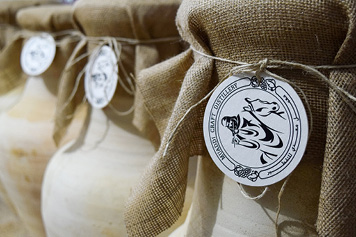
Eventually, the market demanded a more affordable alternative, and so industrial arak was born. Makers cut numerous corners in the production process to reduce costs and maintain profitability. The first to go were grapes because they limited production to a single season and required a labor-intensive process to extract concentrated alcohol from them. To save time and money, makers stopped producing wine as a base for arak. Instead, they imported 96-percent ethanol in bulk, diluted it, and distilled it with aniseed. This allowed for the production of arak quickly, economically, and year-round.
Next, aniseed was removed, as it was a costly input. Instead, producers began to add commercial anethole (which is often made from Chinese star anise instead of aniseed) to the 96-percent ethanol and distilled them together to give the spirit a profile similar to that of arak.
Some makers even abandoned the distillation process altogether and created mixing-and-bottling operations that simply dilute the 96-percent ethanol to a drinkable strength, back-flavor it with commercial anethole, and bottle it. These producers succeeded in creating a more affordable kind of arak, but its palatability is significantly diminished. Even worse, this subpar arak was mislabelled as authentic, baladi (local), triple distilled, and made from grapes and aniseed. The false marketing ruined arak’s reputation for an entire generation of drinkers who didn’t know better and began to regard arak as inherently distasteful and inferior to Western spirits. Not surprisingly, demand even for cheap, industrial arak fell into a downward spiral.
Making arak great again
Disappointed with the state of arak, I embarked on a mission to kick-start an arak renaissance in Palestine, similar to that which occurred in Lebanon after the Civil War. In 2017, I launched Muaddi Craft Distillery, a boutique operation that specializes in genuine, handcrafted, small-batch arak, under the name Arak Muaddi. My goal was to create arak that is made with passion, artistry, and respect for heritage.
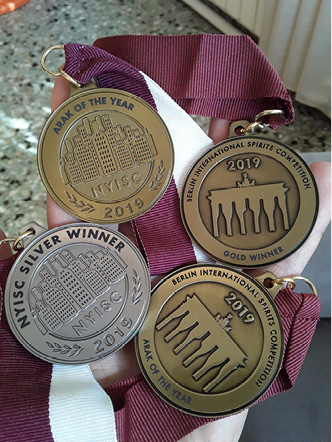
That meant making it baladi again. I sourced indigenous grapes from vineyards located in western Bethlehem and northern Hebron in the villages of Beit Jala, Al-Khader, Shuyukh al-Arrub, Beit Ummar, and Halhoul. The aniseed I use is grown in Raba, Jaba, and Maythaloun near Jenin. I use water from the Ein Ad-Duyuk Spring, just north of Jericho, to dilute it to strength, and I age it in clay amphorae that are handmade in Hebron.
The arak we produce is made according to a traditional recipe and process that has been fine-tuned over a thousand years by our ancestors, and those who’ve tried it are shocked because it’s so different from the industrial arak they are accustomed to.
Our first vintage debuted in November 2018 and was made in the basement of my house in Beit Jala. It consisted of only 480 bottles, but it was a big hit. In fact, it earned a Gold Medal at the Berlin International Spirits Competition, as well as the title “Arak of the Year”; a Silver Medal at the New York International Spirits Competition, as well as the title “Arak of the Year”; and a Bronze Medal at the London Spirits Competition.
I participated in these competitions in an effort to restore arak’s glory and show my people that we have something special that we should revive and take pride in. Arak is a key component of our culinary heritage and hence an integral element of our national identity. It’s just as Palestinian as knafeh, za’atar, and hummus. Yet, arak drinkers are an aging crowd, and I am often fearful that arak may remain nothing but a part of our past.
Nonetheless, I hope that through education and by continually improving its quality, we can ensure that arak will continue to bring joy to future generations and forever remain the Spirit of Palestine.


